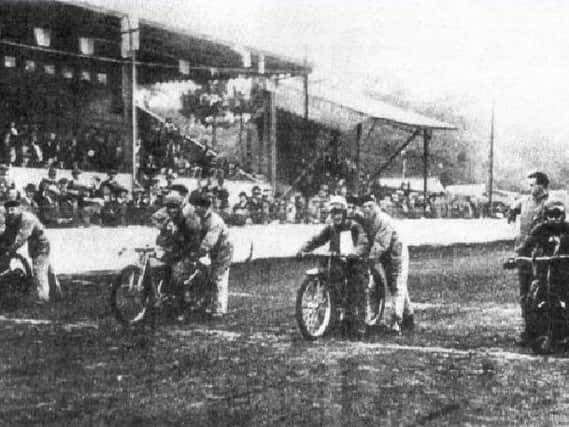Fast and furious world of Preston's speedway racers


On March 29, 1929, Preston’s first, and only, speedway circuit opened on the site of Preston Grasshoppers Rugby Club, which was then at Farringdon Park.
The high octane sport usually involves four motorcycles racing anti-clockwise around an oval circuit, and was a relatively new phenomenon at the time.
Advertisement
Hide AdAdvertisement
Hide AdThe first races were held in Australia in 1905, and in 1928 New Zealander Johnnie Hoskins, credited with inventing the sport, came to the UK to spread the word, opening the first official circuit that year at High Beech,north of London.
Just a year later speedway pioneer W D Meagher, who had also been a director at two other circuits, spared no expense in furnishing Preston’s track with the latest equipment.
Fifty powerful arc lamps for evening racing made for quite a capable floodlighting system, and a PA system was also installed. Cinder was brought in from local mills and used to make the surface of the track, which was reported to be the fastest in the North of England. The first event was held on the evening of March 29. Gates opened at 7pm, which deliberately coincided with the end of Preston North End’s game against Tottenham Hotspur.
Entry was two shillings for adults and one shilling for children, and the hope was people would go straight from Deepdale to the speedway. The track’s official capacity was 20,000, but a spell of cold weather meant construction of one of the stands had been halted which impacted on the capacity on opening night.
Advertisement
Hide AdAdvertisement
Hide AdAround 10,000 people paid for entry but despite the best efforts of the organisers, the turnstiles were wholly inadequate. There were reports of hundreds of, rather too enthusiastic, fans rushing the gates and gaining entry free of charge.
Trams from the nearby tram stop couldn’t cope with the demand, and traffic in the surrounding area ground to a complete stop. Some who could not get in found precarious vantage points atop trees close to the circuit. But those in attendance were not disappointed.
By modern standards,the machines were not particularly quick – they were 415cc Velocette bikes which managed an average lap speed of 37 mph – but they provided great drama. The crowd particularly enjoyed an enthralling encounter between two riders named Anderton and McNab, both from Preston, who passed and re-passed each other numerous times over the four-lap race.
The fans were very impressed with the bravery on display, the like of which they had never seen before. They were reported to have swayed with excitement as riders executed a ‘speed wobble’ as they went round the corners. During this manoeuvre, they switched their engines off momentarily, before stretching their left legs out and leaning the bike inwards to an impossible angle as they took the corner.
Advertisement
Hide AdAdvertisement
Hide AdThey also used a technique known as ‘broadsiding’, during which the back wheel slides out of line to increase cornering speed. Like all motorsport, speedway was never without its risks. On the first night alone, several riders were thrown from their bikes and this trend continued.
On July 24, 1930, what was perhaps the most exciting night of racing at Farrngdon Park was marred by the death of Jimmy Carnie, a popular 23-year-old rider from Accrington. In the second heat of the Golden Helmet event, Carnie’s front wheel clipped the rear wheel of the race leader, sending his bike rolling. Carnie was thrown to the track, where the footrest of the next bike caught him. He was quickly attended to by a doctor and put in an ambulance to hospital, where he was pronounced dead on arrival.
Preston soon formed an official team which entered the Northern Dirt Track League in 1929 which went on to challenge for the league title in its first year, but missed out by just five points, despite racers Joe Abbott and Ham Burrill were both listed in the top five performers for the season.
Many riders from Lancashire competed for years thereafter, and one eventually went on to compete at international level. Joe Abbott, from Burnley, won four consecutive national league championships with Belle Vue Aces between 1933 and 1936, and even rode in the World Championship final at Wembley in 1937.
In spite of the fact Farringdon Park closed in 1932 due to lack of financial interest, the city of Preston definitely enjoyed a passionate, albeit brief, love affair with motorcycle speedway.